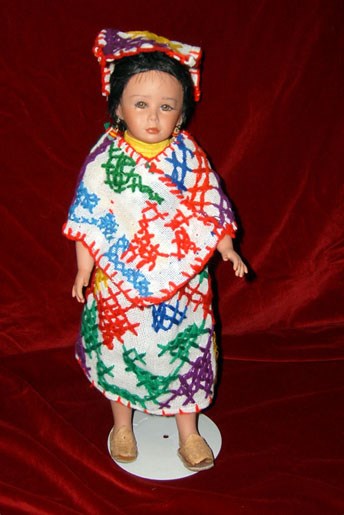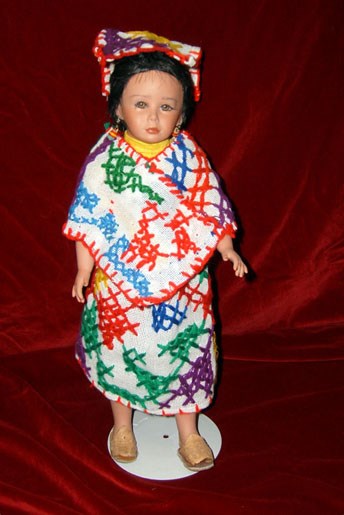
Capital: Pachuca A profusion of figures - turtles, deer, scorpions, rabbits, and birds - in multicolored cross-stitching completely cover the woven poncho, bell-shaped skirt, and petob, a traditional headdress stitched to the hair. The Huastecans, or Teenek, as they call themselves, embroider their clothing with traditional symbols of their mythology: the animals are the environment and family relations, the tree is life, and the star is the for cardinal points. The figures also reflect the Toltec's reverence for nature. All reflect the lives of the indigenous people of Hidalgo - a centrally located, relatively small state with a kaleidoscopic landscape. The Huastecos take their name from the flat, low, hot and humid northern region where they live called the huasteca. This indigenous group occupies parts of Tamaulipas, San Luis Potosi, Hidalgo, and Veracruz. Nearer to the coast, robust inhabitants of the thick forests and rugged mountains, the Huastecos enjoy a profusion of rivers and waterfalls, cultivating rich soil, breeding livestock of excellent quality, and selling fruit and fresh fish -- both of which abound. The Huastecos have the reputation of being as tough as the terrain they live on, and when they find free time, being equally lighthearted and tempestuous. The Otomi occupy various areas of the country, but are concentrated in the states of Mexico, Hidalgo, Puebla, Tlaxcala and Veracruz. Many Otomies live in poverty on the dry and temperate Palquera Highland Plateau. Here, they turn to the poor soil for both shelter and sustenance. They build their homes from the large spiny leaves of the maguey (also called agave) which grows there in profusion, and cultivate the plant to produce pulque. Pulque, a potent alcoholic drink made from fermented maguey sap, has been part of the Mexican culture since pre-Hispanic times. The inhabitants of this region also consume manuey grubs called chinicuiles, as well as ants' eggs known as escamoles. Hidalgo is a major provider of manganese, a mineral used to prevent the corrosion of steel and in the manufacture of batteries, for all of Mexico. Other abundant minerals are iron and zinc, along with lead, gold, and silver ore. Opals, semi-precious stones, are mined in Hidalgo, and the state also quarries stone and marble. In the southern city of Tula, oil is refined and electrical energy generated. But the more impressive attraction is Los Atlantes de Tula, giant stone figures that represent the warrior-priests who served as protectors and guides for the Toltecs, an ancient culture of widespread influence. Did you know...? 
Capital: Pachuca Una gran cantidad de figuras: tortugas, ciervos, alacranes, conejos y pájaros, cubren completamente el sarape multicolor, así como la falda acampanada y el petob, tocado tradicional que adorna el cabello. Los Huastecos o Teenek, bordan su ropa con símbolos mitológicos tradicionales: los animales representan al medio ambiente y las relaciones familiares, el árbol es la vida y la estrella representa los cuatro puntos cardinales. Las imágenes también reflejan el respeto de los Toltecas hacia la naturaleza. Cada elemento refleja la vida de las personas indígenas de Hidalgo, estado localizado en el centro del país, presenta un paisaje calidoscópico. Los Huastecos toman su nombre de la región norteña llamada Huasteca. Este grupo indígena ocupa parte de los estados de Tamaulipas, San Luis Potosí, Hidalgo, y Veracruz. No muy lejos de la costa, los robustos habitantes de los densos bosques y abruptas montañas, disfrutan de la abundancia de ríos y cascadas, cultivan el rico suelo, crían ganado de excelente calidad y venden fruta y pescado fresco. Los Otomíes se localizan en varias regiones del país, pero so concentran en los estados de México, Hidalgo, Puebla, Tlaxcala, y Veracruz. Muchos Otomíes viven en la pobreza sobre la meseta de la Pulquera. Aquí, buscan refugio y sustento. Construyen sus casas de las grandes hojas del maguey (también llamado agave) que crece en abundancia, también cultivan la planta para producir pulque. El pulque, potente bebida alcohólica hecha de la savia de maguey fermentada, ha sido parte de la cultura mexicana desde tiempos prehispánicos. Los habitantes de esta región comen el gusano de maguey llamado chinicuiles, así como los huevos de las hormigas conocidos como escamoles. Hidalgo es un proveedor principal de manganeso, mineral utilizado para prevenir la corrosión del acero y en la fabricación de pilas de todo México. Otros minerales abundantes son el hierro y el zinc, junto con el plomo, oro y plata. Los ópalos, piedras semipreciosas, son extraídos en Hidalgo además de cantera y mármol. En la ciudad sureña de Tula se extra petrólero y se genera energía eléctrica. Pero la atracción más impresionante son Los Atlantes de Tula, figuras gigantescas de piedra que representan a los sacerdotes-guerrero que sirvieron como protectores y guías para los Toltecas, cultura antigua de vasta influencia. Sabías que...? |
Last updated: February 24, 2015
